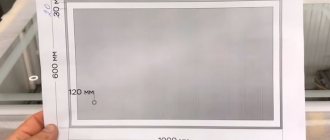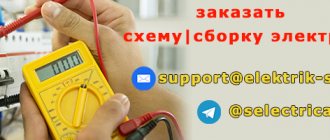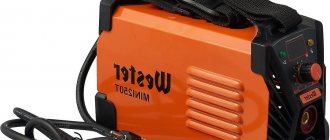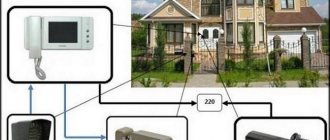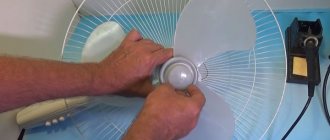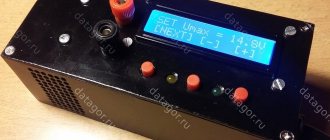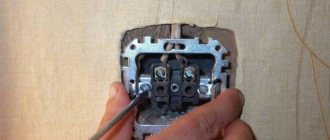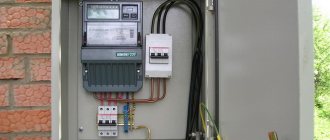Typical diagram for connecting a motor via a magnetic starter
This wiring diagram for a three-phase motor should be given the closest attention. It is most common in all industrial equipment produced until about the 2000s. And in new Chinese machines and other simple equipment with 2-3 engines they are still used to this day.
An electrician who does not know it is like a surgeon who cannot distinguish an artery from a vein; as a lawyer who does not know Article 1 of the Constitution of the Russian Federation; like a dancer who does not distinguish a waltz from a tectonic.
In this circuit, three phases go to the motor not through the machine, but through the starter. And the starter is turned on/off using the “ Start ” and “ Stop ” buttons, which can be placed on the control panel through 3 wires of any length.
An example of such a circuit is in the article about restoring the circuit of a hydraulic press, see the last circuit in the article, KM0 starter.
5. Diagram of connecting the motor through a starter with start-stop buttons
Here, power to the control circuit comes from phase L1 (wire 1 ) through a normally closed (NC) “Stop” button (wire 2 ).
Often in such schemes the starter does not turn on due to the fact that the contacts of this button “burn out”.
The diagram does not show a control circuit breaker; it is placed in series with the “Stop” button, the rating is several amperes.
If you now press the “Start” button, the power circuit of the coil of the KM electromagnetic starter will close (wire 3
), its contacts will close, and three phases will go to the motor. But in such schemes, in addition to three “power” contacts, the starter has one more additional contact. It is called a “locking” or “self-latching contact”.
Not to be confused with blocking in reverse circuits, see below.
The “Self-Pickup” contacts are physically located on the same mount with the power contacts of the contactor, and operate simultaneously.
When the electromagnetic starter is turned on by pressing the SB1 “Start” button, the self-retaining contact also closes. And if it is closed, then even if the “Start” button is pressed, the power circuit of the starter coil will still remain closed. And the engine will continue to run until the “Stop” button is pressed.
It often happens in such schemes that the starter does not “self-retain.” It's about that fourth contact.
Types of contactors and applications
Such devices differ depending on the type of connection break into dual models, which are characterized by increased operational safety, and single analogues, used for hydroelectric power plants, railway cars, and induction furnaces. Based on the type of control, switching devices are divided into models with manual or remote control.
Depending on the type of installation, frameless and framed contactors are distinguished. Depending on the type of electric current, there are DC and AC voltage models. These mechanisms are also classified according to the number of poles, rated current and voltage, as well as operating frequency.
For anyone who does not understand why a contactor is installed, it is recommended to imagine how difficult it would be for people to get along without such devices. Thanks to such inventions, the danger of short circuits and fires in production is minimal. Since these two-position devices control the flow of current in certain circuits, their scope of application is quite wide:
- automation of lighting systems;
- household spheres and public transport (trams, trolleybuses, electric locomotives, elevators);
- industrial production;
- automotive systems;
- organizing the operation of various systems and equipment (heated floors, fans, heating pumps, compressors, etc.);
- prompt load switching at different facilities.
Conventional modular contactor
Using a conventional modular contactor, remote control of electrical consumers is organized via radio or Wi-Fi communication channel. The smart home system is capable of taking into account many specified parameters.
For example, through a “smart” thermometer it is possible to organize control of electric heaters without human intervention. When the air temperature in the room decreases, the thermometer will give the contactor a command to turn on the outlet to which the heater is connected. When the set temperature is reached, the outlet will automatically turn off power. In this case, the contactor will be installed in the electrical panel, that is, externally such a system is no different from a conventional one.
If necessary, a gas boiler is connected via a remote contactor. This will save money, because a gas boiler with GSM control costs much more than a conventional one. If necessary, the contactor can be turned on from any geographical point, the gas boiler will start working, and the house will warm up well by the time the owner arrives.
We recommend reading: How to make a tube headphone amplifier with your own hands
The modular contactor has a number of advantages over other models:
- Silence. Switching occurs through a small relay that produces a quiet click. More expensive models are equipped with solid-state relays that do not make sounds at all.
- Easy installation. Most contactors can be mounted on a DIN rail, which is equipped with all electrical panels.
- High versatility. Contactors are available for sale with any rated current, voltage and number of contacts. Some of them have a diode bridge, which allows you to connect DC consumers to the contactor.
- High reliability. Contactors have a large safety margin, and many models are equipped with noise suppression systems, protecting expensive equipment connected to it.
Electromagnetic contactor
A simple electromagnetic contactor differs from a modular one in the way of switching, namely, it has an electromagnetic coil. To organize power supply for consumers, block contacts are used. When the contactor is turned on, all contacts operate simultaneously.
The use of such contactors is advisable for switching powerful or three-phase electrical consumers: water pumps, a lathe in a workshop, and so on.
An electromagnetic contactor can also be installed in a home's electrical panel and controlled remotely or via signals from various relays.
Most often, such contactors can be found in a water supply system with a hydraulic accumulator. The block contacts are set to a normally closed state; when the contactor is turned on, the well pump supplies water to the hydraulic accumulator. When the required pressure inside the accumulator is reached, the pressure switch sends a command to turn off the contactor. The process is repeated as water is consumed by the residents of the house.
Depending on the power, when the consumer is disconnected, sparking of the contacts may occur, which has a detrimental effect on their service life. Electromagnetic contactors are equipped with arc-extinguishing chambers, making it possible to disconnect consumers under load without the risk of high-temperature electric arc formation.
Connection diagram for a starter with a thermal relay
In the circuit above, I left out the thermal protection for the sake of simplicity of the circuit. In practice, a thermal relay of the RTL type is necessarily used (at least, this was accepted before 2000 for us and until 1990 for “them”)
6. Connection diagram of the starter with buttons and thermal relay
As soon as the motor current increases above the set one (due to overload, phase loss), the contacts of the thermal relay RT1 open and the power circuit of the electromagnetic starter coil breaks.
Thus, the thermal relay acts as a “Stop” button, and is in the same circuit, in series. Where to put it is not particularly important, it can be in the section of the L1 - 1 circuit, if it is convenient for installation.
However, a thermal relay does not protect against short circuits to the housing and between phases. Therefore, in such schemes a circuit breaker must be installed, as shown in Diagram 7:
7. Connection diagram of the starter with automatic buttons and thermal relay. PRACTICAL SCHEME
Attention! The control circuit (the circuit through which the KM starter coil is powered) must be protected by a circuit breaker with a current of no more than 10A. This circuit breaker is not shown in the diagram. Thanks to attentive readers!)
The current of the QF motor circuit breaker does not need to be selected as carefully as in scheme 3, since the RTL can handle the thermal overload. Enough so that it protects the suitable wires from overheating.
Example. The motor is 1.5 kW, the current in each phase is 3A, the thermal relay current is 3.5 A. The motor power wires can be taken 1.5 mm2. They hold current up to 16A. And it seems like the machine can be set to 16A? However, there is no need to act clumsily. It’s better to put something in between – 6 or 10A.
Characteristics of contactors
To choose the right device for your needs, you need to know what characteristics this type of device has and how they differ. Typically, electromagnetic contactors have the following important characteristics:
- Limit and rated voltage;
- Correlation of work with various circuit breakers (protecting against short circuits);
- Parameters and types of acceleration regulators of automatic circuit breakers;
- Characteristics and type of resistances;
- Type and nature of relays and releases and other elements in its composition.
Connection diagram of the magnetic starter from the controller
Over the past 10 years, controllers have been widely used in new industrial automation. The starter coils are also switched on from the controller outputs. And in this case, to protect against short circuits and thermal overheating, motor connection diagram number 8 is used:
8. Connection diagram for a starter controlled by a controller. PRACTICAL SCHEME
In the diagram, QF is an automatic motor, or motor protection circuit breaker, as in diagram 4. I just depicted it in a modern way. In this case, the starter connection diagram is “hidden” in the dotted line. There is a controller there that controls everything and turns on the engine according to the program embedded in it.
When the engine is overloaded, the automatic motor turns it off and opens its additional (fourth, signal) contact. This is only necessary to “inform” the controller about an accident. Often this contact simply enters the control circuit and stops the entire machine.
Connection diagram for reversing magnetic starter
In fact, these are two magnetic starters, combined electrically and mechanically, more details below.
Reversible motor control
A reversing starter is needed when it is necessary for the motor to rotate alternately in both directions.
Right rotation (used most often) - when the engine rotates clockwise when looking at its rear. Left rotation - counterclockwise.
Changing the direction of rotation is realized in a well-known way - any two phases are swapped. Look at the motor reverse circuit diagram below:
9. Connection diagram for a 220V reversible magnetic starter with button control. PRACTICAL SCHEME
When the KM1 starter is turned on, it will be “right” rotation. When KM2 is turned on, the first and third phases change places, the engine will spin “to the left”. Turning on the starters KM1 and KM2 is realized by different buttons “ Start forward ” and “ Start reverse ”, turning off is done by one common button “ Stop ”, as in circuits without reverse.
Pay close attention to the triangle between the power contacts KM1 and KM2. It means “foolproof.” It may happen that for some reason both starters turn on at once. A short circuit will occur between phases L1 and L3. You can say, “So what, we have a QF automatic engine, it will save us!” What if it doesn’t save you? And while he is saving, the contacts of the starters will burn out!
Therefore, the reversing starter must have mechanical protection against simultaneous activation of its two halves. And if it consists of two separate starters, a special mechanical interlock is placed between them.
Now look at the contacts KM2.4 and KM1.4, located in the power circuits of the starter coils. This is electrical protection from the same fool . For example, if KM1 is turned on, its NC contact KM1.4 is open, and if our fool, with all his foolishness, presses both “Start” buttons at once, nothing will happen - the engine will obey the button that was pressed earlier.
Mechanical and electrical protection must always be present in the connection diagram of the reversing starter; they complement each other. Not installing one or the other is bad manners among electricians .
Important! If there is even a minimal probability of the engine rotating in the wrong direction, be sure to install a phase control relay! Here is an example - how we burned a screw compressor worth several thousand euros due to the fact that the phases were mixed up when connecting.
To implement electrical interlocking of simultaneous switching on and self-retaining, each starter requires, in addition to power ones, one more NC (blocking) and NO (self-retaining). But since, as a rule, there is no fifth contact in starters, you have to install an additional one. contact. For example, for a PML type starter, the PKI prefix is used. And if, as in scheme 8, a controller is used, self-retaining is not needed, and one NC contact for each direction of rotation is sufficient.
Reversible hydraulic control
And here is an example of reverse valve control, from an article about a hydraulic press:
Electrical circuit for hydraulic control
The fact that relays are used should not be confusing. In fact, a contactor and a relay are one device, the only difference is in the design and parameters.
In fact, the circuit repeats the circuit for the engine, only instead of the “Stop” button there are two limit switches, and buttons SB1, SB2 - with additional NC blocking contacts. A detailed description of how the circuit works is here.
The operation of the reversing starter is also described in detail in the article about connecting the generator to the home network.
Why do you need a contactor?
Just like the subtypes, the original contactor is needed to control the electrical circuit. But it has several operating features:
the ability to fully automate the switching on and off of the circuit;
high speed of operation, allowing the circuit to be closed and opened up to several thousand times per hour.
Thanks to these features, contactors are used in areas where electrical circuits need to be activated regularly and frequently. Doing this manually is not only inconvenient, but even ineffective. So it is better to entrust the work to an automated system.
Difference between 220V and 380V starters
Coils of magnetic starters for operation in 380V networks can be 220 and 380 Volts without any special modifications to the circuit. In all the diagrams given in this article, electromagnetic starters have a coil for a voltage of 220 V. What to do if you get a starter not for 220 V, but for 380 V?
Everything is very simple - you need to connect the lower (according to the diagram) terminal of the 380V starter coil not to zero (N), but to L2 or L3. This circuit is even more preferable, since the entire circuit with a 380V starter can be assembled without a zero at all. Three phases come in, and three phases go out to the engine, not counting the control.
Where are contactors used?
What are contactors used for? The areas of application of these devices are varied:
- utilities: management of lighting, elevators, ventilation and heat and water supply systems;
- in industry and construction, contactors are found in almost all electrical devices;
- for electric transport: in trams and trolleybuses, these devices are responsible for the operation of the traction motor;
- in domestic conditions, with the help of contactors, they automate the operation of intra-house electrical networks.
Depending on the functions, there are also highly specialized contactors designed to work, for example, only with motors or construction electrical equipment. Before you buy a device of this type, you need to decide exactly where and under what conditions it will work.

